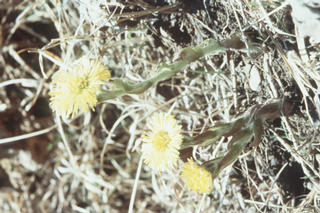Tussilago farfara
Contents
Nomenclature
Other Names:
Historical Use of Tussilago farfara
Tussilago farfara in Traditional Chinese Medicine
Background
Zhikuandong Ö˿
Chinese Name (pinyin): Kuandonghua
Chinese Name :
Common Name :Coltsfoot Flower
Specific Name : Flos farfarae
Scientific Name:
Collection : The drug is collected in December or before the ground is frozen while the flower is still under the ground, remove from pendicels and soil and dried in the shade.
Description : Long clavate, solitary or 2 - 3 accreted at the base, 1 - 2.5cm long, 0.5 - 1cm in diameter. The upper part broader and the lower part gradually slender or pedicelled, enclose by numerous scaly bracts. The outer surface of the bracts purplish red or pale red, inner surface densely covered with white flocky hairs. Light, showing white hairs after ripping. Odour aromatic, taste slightly bitter and pungent
Identification :
Processing : Eliminate foreign matter and residual pedicels.Processed with honey: stir fry as describe under the method for stir frying with honey (Appendix ll D) until it is no longer sticky to fingers.
Action : To relieve cough and resolve phlegm to nourish the lung to keep the adverse qi downward.
Indication :
Precautions :
Dosage : 5 to 9 g.
Storage : Preserve in a dry place, protected from moisture and moth.
Synonymns for Tussilago farfara
Patent Medicines and Medicines with Multiple Ingredients that include Tussilago farfara
Pharmaceutical Information
Chemical Constituents
Evidence or the Use of Tussilago farfara in the Treatment of Epilepesy
Basic Science
Animal Studies
Cohort, Case-Control and Non-Randomized Trials
Randomized Controlled Trials
Meta-Analysis
1st Five Results: pubmed search
